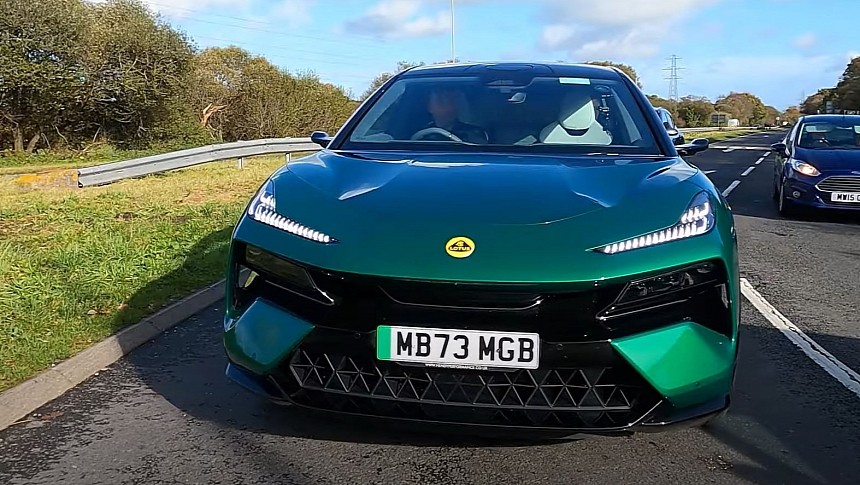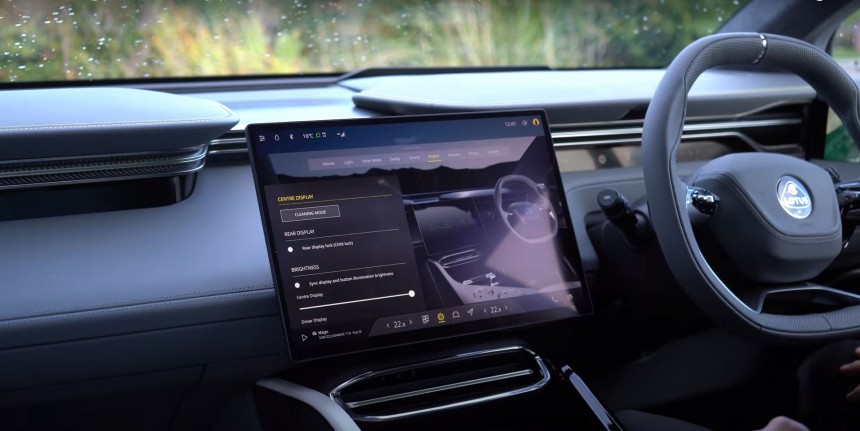Now that Lotus is finally back on its feet, should prospective EV buyers give it a chance? Don't worry if you aren't ready to answer that question for yourself just yet. A former Tesla Model Y Long Range owner did. Here's what they have discovered.
Lotus currently sells three versions of its first SUV, and it just so happens to be battery-electric. Customers can order the Eletre, the Eletre S, and the Eletre R. Prices start from £89,500 ($111,490) for the base model, go up to £104,500 ($130,176) for the middle option, and reach the £120,000 ($149,484) mark for the top version with a Taycan-like two-speed gearbox integrated into the rear axle.
This particular customer got the "entry-level" Eletre. Finished in Galloway Green, the eSUV looks strikingly good without commanding your attention. It's going to pique your interest for sure, but your eyesight won't be bothered by it. The color compliments the vehicle's silhouette and helps it retain that British-specific elegance.
But this all-wheel-drive Chinese-made vehicle isn't only about looks. It puts out 603 hp, promises a range of 373 mi enabled by a 112-kWh (gross capacity) battery boasting the 800V architecture, and features active air suspension plus Kinematic Posture Control-like torque vectoring. The latter means the vehicle uses the brakes to apply stopping force to a single wheel for sharper cornering. Rear-wheel steering is also available, which this customer optioned.
When it comes to electricity consumption, 23.2 miles covered in the city and on the highway at an average speed of 23.2 mph on a rather cold day with no preconditioned battery and a few mild sprints here and there revealed that the SUV consumed 9% of the battery. The computer displayed an efficiency of 41.1 kWh per 100 miles or 2.4 miles per kWh for that quick trip. But the Eletre is relatively new, and things could improve along the way. The manufacturer might unlock more of the battery buffer if it deems it feasible.
The standard features list includes keyless entry (key fob needed), a plethora of safety and driver-assistance features, Apple CarPlay, Android Auto, a 15-speaker, 1,380-watt KEF sound system, a 15.1-inch OLED infotainment screen, 5G, cameras instead of side mirrors, a 29-inch head-up display with some Augmented Reality implementations, and matrix LED headlights.
Even in entry-level spec, the Wuhan-born Eletre feels almost complete. It nearly ticks all the right boxes. Some could even consider it too much.
This customer, however, added a couple of options. He chose a different 22-inch wheel design that features carbon fiber rim inserts, the active aero pack, a more capable A/C system, configurable interior lighting, the electrochromic panoramic glass roof, and the dynamic handling pack, and tinted windows for the rear passengers. Those upgrades meant the cost rose to almost £111,000 ($138,273).
That's more than double the VAT-including price of a Tesla Model Y Long Range. The popular crossover SUV costs £52,990 ($66,010) in the UK, while Americans look at an MSRP of $48,990. Given that discrepancy, anyone would rightfully expect the Lotus to be better and maybe even twice as good as the Tesla.
But while the Eletre is a major upgrade from the Model Y on some levels, there still are some misses Lotus should take care of. The owner of the eSUV believes the vehicle would benefit from better efficiency, some software polishing that should add popular apps like Netflix or YouTube, and the phone key.
Fortunately, these are suggestions that can be addressed via over-the-air software updates. Lotus could take care of them as more customer feedback is received.
The Eletre buyer also mentioned Supercharger access as a Lotus "cons," but that's not something we would take into account. The 800V architecture enables charging speeds of up to 350 kW, and the Ionity network supports this feature thanks to a wide network of high-power stalls. That's something Tesla's EVs can't currently take advantage of. But V4 Superchargers are just around the corner!
This particular customer got the "entry-level" Eletre. Finished in Galloway Green, the eSUV looks strikingly good without commanding your attention. It's going to pique your interest for sure, but your eyesight won't be bothered by it. The color compliments the vehicle's silhouette and helps it retain that British-specific elegance.
But this all-wheel-drive Chinese-made vehicle isn't only about looks. It puts out 603 hp, promises a range of 373 mi enabled by a 112-kWh (gross capacity) battery boasting the 800V architecture, and features active air suspension plus Kinematic Posture Control-like torque vectoring. The latter means the vehicle uses the brakes to apply stopping force to a single wheel for sharper cornering. Rear-wheel steering is also available, which this customer optioned.
When it comes to electricity consumption, 23.2 miles covered in the city and on the highway at an average speed of 23.2 mph on a rather cold day with no preconditioned battery and a few mild sprints here and there revealed that the SUV consumed 9% of the battery. The computer displayed an efficiency of 41.1 kWh per 100 miles or 2.4 miles per kWh for that quick trip. But the Eletre is relatively new, and things could improve along the way. The manufacturer might unlock more of the battery buffer if it deems it feasible.
The standard features list includes keyless entry (key fob needed), a plethora of safety and driver-assistance features, Apple CarPlay, Android Auto, a 15-speaker, 1,380-watt KEF sound system, a 15.1-inch OLED infotainment screen, 5G, cameras instead of side mirrors, a 29-inch head-up display with some Augmented Reality implementations, and matrix LED headlights.
Even in entry-level spec, the Wuhan-born Eletre feels almost complete. It nearly ticks all the right boxes. Some could even consider it too much.
That's more than double the VAT-including price of a Tesla Model Y Long Range. The popular crossover SUV costs £52,990 ($66,010) in the UK, while Americans look at an MSRP of $48,990. Given that discrepancy, anyone would rightfully expect the Lotus to be better and maybe even twice as good as the Tesla.
But while the Eletre is a major upgrade from the Model Y on some levels, there still are some misses Lotus should take care of. The owner of the eSUV believes the vehicle would benefit from better efficiency, some software polishing that should add popular apps like Netflix or YouTube, and the phone key.
Fortunately, these are suggestions that can be addressed via over-the-air software updates. Lotus could take care of them as more customer feedback is received.
The Eletre buyer also mentioned Supercharger access as a Lotus "cons," but that's not something we would take into account. The 800V architecture enables charging speeds of up to 350 kW, and the Ionity network supports this feature thanks to a wide network of high-power stalls. That's something Tesla's EVs can't currently take advantage of. But V4 Superchargers are just around the corner!













